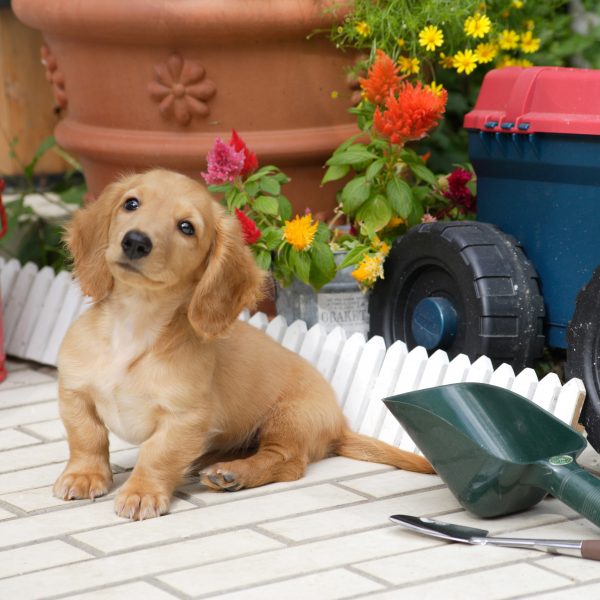4 Dog-Friendly Gardening Tips

If you are a fan of gardening and have a dog, or are planning to add a dog to your family, it’s important to make this hobby dog-friendly. Use these dog-friendly gardening tips to help protect your dog and also protect all of your hard work in the garden:
1. Make Sure All of Your Plants are Dog-Friendly
One of the biggest dog-friendly gardening tips is to make sure all of your plants and flowers are dog-friendly. You want to make sure none of them are poisonous plants to dogs like Aloe Vera, Philodendron, or others. If you have a vegetable or herb garden where you are planning to grow any foods that may be toxic to your dog, like onions or garlic, consider how much you need it and either get rid of it or make sure it is securely fenced to keep your dog out of it.
Also, make sure you avoid chemical pesticides and herbicides and use a pet-friendly version instead. Starting off with dog-friendly plants ensures that your dog will be fine in case they end up eating them or chewing on them. These are also essential spring safety tips for dogs.
2. Plan Ahead for Starting a New Garden Plot
If you are just starting a garden or are starting an additional garden plot, take the time to plan ahead with your dog. You may not be able to ask them for their opinion and get a verbal answer that you understand, but you can observe their behavior. There may be certain parts of the yard that they favor for some reason or another.
If they’re already used to using those spots as a preferred bathroom spot, place to roll or lie down, or pace or run, then you know those areas of the yard are not a great spot for your new garden – at least not if you want to keep your dog out of it! It will be much more difficult to train them to stay out of a garden that is located in a spot they have already claimed and made a habit of using than one in an area they don’t normally use.
3. Protect Existing Gardens
You also want to make sure you protect your existing gardens. A mix of training, fencing, and pathways can help you keep your garden dog-friendly and protected.
Training Your Dog
Start training your dog to stay out of the garden beds and to leave the plants alone. This is much easier if “leave it” is one of the basic commands your dog has mastered. You can also teach your dog a specific “get out of the garden” command. As with any training, make sure you are maintaining consistency with the rules and boundaries you are trying to create to avoid confusion and help your dog pick it up faster.
Putting up Physical Boundaries and Making Pathways
In addition to training your dog to stay out of the garden beds, you can also create physical boundaries around your plants to help discourage canine entry. Wire fences, wooden fences, stone walls, cages, and more can help create a physical boundary between your plants and your dog.
Raised garden beds and container gardens can also create a clear physical boundary. You can also create specific pathways that are easy for your dog to navigate, if you are planning to add pathways to your garden. A clear stone, brick, paved, or wooden pathway creates a path of least resistance for your dog and is often more attractive for walking or running than a wall of plants, especially if the plants are also protected by a boundary.
4. Figure Out Why Your Dog is Getting in the Garden and Redirect
If your dog continues to get into your garden while you are training them to stay out of it, there may be a reason for it. Figure out why your dog keeps getting in the garden and redirect them or provide a solution.
Provide Shade in Other Areas
Is the garden the coolest part of the yard on a warm day? If so, your dog may be lying there because it helps them cool off and no other shade is available. By providing shady spots in areas of the yard where your dog is allowed to be, you can resolve the initial problem and start redirecting them to the new areas. If they can cool off just as well in another area of the yard, they don’t have to use your garden bed.
Avoid Bare Soil
Large patches of bare soil are tempting for dogs, especially if they are a dog breed that is prone to digging. You can plant groundcover plants to help cover the bare soil. Coral Bells, Plantation Lily, or Thyme tend to be popular options for groundcover. If you have to have bare soil patches in your garden, plan to install a sturdy protective fence around it temporarily to make sure your dog stays out.
Tire Your Dog Out
Also, consider whether your dog has had enough exercise, attention, and mental stimulation. If they are bored, are craving your attention, or have not had enough exercise, they may end up misbehaving and being destructive in your garden. So, make sure they have gotten plenty of exercise before letting them near your garden again. After all, they won’t be destroying your garden if they’re too busy taking a nap in the sun.
Gardening is a fun, relaxing, and rewarding hobby for many people. If you love gardening and dogs, then using these dog-friendly gardening tips can help your favorite hobby and your best furry friend live in harmony.
